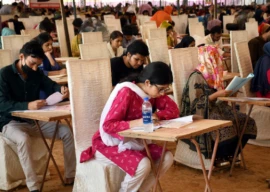
The lake’s major and permanent water source, the Kalri Baglihar Feeder canal, which springs from the Kotri barrage in Jamshoro, and the seasonal drains will also be regularly monitored. An effluent treatment plant in the Kotri SITE area, which dumps industrial waste in the KB Feeder, is also likely to start working by the same time.
“There will be a daily check of the feeder’s water quality and once a week on Horlu and other drains,” said Dr Ahsan Siddiqui, the independent water expert who has been assigned the monitoring task. “The Karachi Water and Sewerage Board will arrange a lab at Keenjhar and will also pay the cost.”

This was decided on Wednesday at a meeting chaired by Hyderabad Commissioner Ahmed Bux Narejo. The water board’s MD Misbahuddin Farid, the environment protection agency’s regional director, Mujeeb Shaikh, deputy commissioners of Jamshoro and Thatta, and staff from the irrigation and SITE departments attended. This was the first time, in half a dozen meetings since September last year, that the water board’s chief was attending.
The lake’s contamination in April last year alarmed the people of Thatta and Karachi and endangered the lives of the people living around the lake. It took over a week to dilute the mess by increasing the canal’s water discharge from Kotri barrage. The canal’s capacity is around 8,000 cusecs. But it is currently being supplied 5,200 cusecs.
According to Siddiqui, about Rs500,000 a month will be needed to check the water samples. They will work with the water board to decide which points along the canal and drains to monitor.

At the meeting, the water board complained that nothing was being done to stop factories from dumping industrial waste from Kotri into the canal. The MD suggested to channel the wastewater towards the Nai Baran drain. However, Commissioner Ahmed Bux Narejo opposed the idea, assuring him that the 2.5 MGD combined effluent treatment plant in Kotri will be working in a week.
The inauguration of the plant, which was built in April, 2010, on orders of the Sindh High Court, was supposed to happen in December 2012 - 13 months from the court’s deadline. However, the SITE chief engineer told the officials that encroachments over the inlets and outlets of the treatment plant were creating difficulties.
“We have found high toxic levels in ten of the 32 industries which dump wastewater directly in the canal,” said the environment protection agency’s Mujeeb Shaikh. However, six of these industries have submitted in writing to the environment tribunal that they will install in-house treatment plants within the next six to 12 months. The rest, he told The Express Tribune, have been issued notices for hearing by the tribunal.

The commissioner assured the officials that he will personally ensure that the plant is up in a week. The plant has been built at a cost of around Rs800 million. It has five huge treatment tanks and one collection tank in addition to six ponds to collect the industrial waste.
Published in The Express Tribune, February 15th, 2013.

1726117332-0/Megan-Thee-Stallion-(1)1726117332-0-165x106.webp)





















COMMENTS
Comments are moderated and generally will be posted if they are on-topic and not abusive.
For more information, please see our Comments FAQ